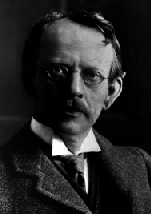|
Experiments with beams of negative particles were performed in Britain by Joseph John ("J.J.") Thomson, and led to his conclusion in 1897 that they consisted of lightweight particles with a negative electric charge, nowadays known as electrons. Thomson was awarded the 1906 Nobel Prize. The word "elektron" in Greek means amber, the yellow fossilized resin of evergreen trees, a "natural plastic material" already known to the ancient Greeks. It was known that when amber was rubbed with dry cloth--producing what now one would call static electricity--it could attract light objects, such as bits of paper.
|  J. J. Thomson. J. J. Thomson.
|
 Official GSFC Home Page
Official GSFC Home Page  NASA WWW Home Page
NASA WWW Home Page